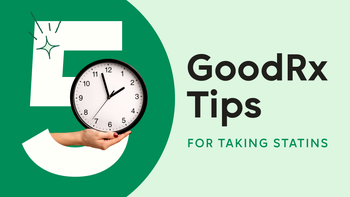
11 Atorvastatin Interactions to Watch Out for
Key takeaways:
Atorvastatin (Lipitor) is a popular medication used to treat high cholesterol. Although it’s effective, it has a number of interactions.
Common medications that interact with atorvastatin include Paxlovid (nirmatrelvir/ritonavir), some medications used to treat HIV, and other cholesterol medications. Grapefruit juice also interacts with atorvastatin.
Many atorvastatin interactions raise the risk of side effects. This includes muscle pain or weakness.

Atorvastatin (Lipitor) is one of the most prescribed medications in the U.S. Millions of people take this statin medication for high cholesterol. Atorvastatin can help lower the risk of heart disease by lowering cholesterol and triglyceride (a type of fat) levels. It works by blocking the production of cholesterol in the liver.
But while effective, atorvastatin has many interactions with other medications. So, which atorvastatin interactions should you be most aware of?
11 atorvastatin interactions to know about
Atorvastatin has many possible interactions. Here, we'll review some notable ones you should know about. Keep in mind that this list doesn’t include all possible atorvastatin interactions.
1. Grapefruit and grapefruit juice
Grapefruit and grapefruit juice can increase the amount of atorvastatin in the body. This can raise your risk of side effects, like muscle pain or weakness. In rare cases, this can lead to rhabdomyolysis (a breakdown of muscle that can cause harm to your kidneys).
But, this interaction usually is only a problem when you drink a lot of grapefruit juice (about 5 cups or 1 liter per day or more). So, having a small glass every now and then shouldn’t be a problem.
2. Paxlovid
Paxlovid (nirmatrelvir/ritonavir) is an antiviral medication authorized to treat COVID-19 in certain people. But the ritonavir in Paxlovid stops the breakdown of atorvastatin in the body. This can cause atorvastatin to build up, raising your risk of side effects. Your healthcare provider will likely have you stop taking atorvastatin until you finish Paxlovid.
3. Other antiviral medications
Like Paxlovid, other antiviral medications can stop the breakdown of atorvastatin. Many of these antivirals are prescribed for people living with HIV or hepatitis C. With some antivirals, atorvastatin should be avoided. For others, lowering the dosage of atorvastatin is enough to manage this interaction.
Examples of antivirals that may interact with atorvastatin include:
Harvoni (ledipasvir/sofosbuvir)
Kaletra (lopinavir/ritonavir)
Lexiva (fosamprenavir)
Prezcobix (darunavir/cobicistat)
Zepatier (elbasvir/grazoprevir)
Mavyret (glecaprevir/pibrentasvir)
4. Cyclosporine
Cyclosporine (Sandimmune) is used to help prevent organ rejection after a transplant. But, it can interact with atorvastatin and stop it from breaking down. Like the medications already discussed, this can raise your risk of atorvastatin side effects. It’s not recommended to take these two medications together. So if you take cyclosporine, you’d likely need to take a different cholesterol medication.
5. Fibrates
Fibrates, like gemfibrozil (Lopid) and fenofibrate (Tricor), are another group of cholesterol medications. But like atorvastatin, fibrates have a risk of causing muscle pain and rhabdomyolysis. So taking fibrates and atorvastatin together increases this risk even more.
Gemfibrozil seems to have the highest chance of causing an interaction with atorvastatin. So it’s recommended to avoid combining these two medications. Other fibrates may be used with caution. If you’re taking both a fibrate and atorvastatin, contact your healthcare provider right away if you start to experience any muscle pain.
6. Azole antifungals
Many azole antifungals can also slow the breakdown of atorvastatin. This can cause a build-up of atorvastatin in the body and raise your risk of side effects. This atorvastatin interaction would only be a concern if you’re taking these antifungals by mouth. Antifungal creams applied to the skin shouldn’t be a problem.
Examples of azole antifungal that interact with atorvastatin include:
Itraconazole (Sporanox)
Posaconazole (Noxafil)
Voriconazole (Vfend)
Your healthcare provider may have you stop atorvastatin while taking your antifungal medication. But, they may also recommend you take both and just watch for atorvastatin side effects.
7. Macrolide antibiotics
Macrolides are a commonly prescribed group of antibiotics. But some, like erythromycin (Ery-Tab) and clarithromycin (Biaxin XL), can lead to higher atorvastatin levels in the body. This raises the risk of side effects, including muscle pain or rhabdomyolysis.
Atorvastatin’s manufacturer recommends watching for any new side effects if you start taking a macrolide. But your healthcare provider may suggest stopping atorvastatin until you finish your antibiotic.
8. Niacin
Niacin (Niacor) is a type of B vitamin (vitamin B3) that can be used to help lower cholesterol. But large doses (typically more than 1,000 mg per day) interact with atorvastatin. Niacin can raise your risk of developing muscle pain or rhabdomyolysis from atorvastatin.
If your healthcare provider feels you should take both medications, they’ll likely prescribe a lower dose of niacin. If you start to experience any muscle pain or weakness, let your provider know.
9. Colchicine
Colchicine (Colcrys) is a medication used to help treat and prevent gout. There are some reports of colchicine causing muscle pain and rhabdomyolysis when combined with atorvastatin. If you take both medications, let your healthcare provider know if you notice any new atorvastatin side effects.
10. Digoxin
Digoxin (Lanoxin) is a medication you may take if you have heart failure or an abnormal heart rhythm called atrial fibrillation. Atorvastatin can raise the amount of digoxin in the body. This can raise your risk of digoxin side effects, like blurred vision or dizziness. You may need more frequent blood tests to check your digoxin levels if you take both medications.
11. Certain birth control pills
Atorvastatin interacts with birth control pills that include the hormones norethindrone or ethinyl estradiol. Atorvastatin increases the amount of these hormones in your body. This may make side effects from birth control pills more likely. This interaction is only known to apply to oral forms of contraception. Options like the patch and vaginal ring don’t seem to be affected by atorvastatin.
Examples of birth control pills that include these hormones include:
Ethinyl estradiol/levonorgestrel (Aviane, Sronyx, Vienva, Jolessa)
Ethinyl estradiol/norethindrone (Junel 1/20, Junel 1.5/30)
Ethinyl estradiol/norgestimate (Tri-Previfem, Tri-Sprintec)
Norethindrone (Camila, Heather)
When should I contact my healthcare provider about an atorvastatin interaction?
Contact your healthcare provider or pharmacist if you start any new medications while taking atorvastatin. This will help them screen for potential interactions. They can also provide tips for managing them. If you’re taking a medication that interacts with atorvastatin, watch for any new muscle pain. Let your provider know if this happens.
It’s a good idea to make and maintain a complete medication list. Be sure to include over-the-counter medications, vitamins, and supplements as well. A medication list can help your healthcare team better check for drug interactions.
The bottom line
Atorvastatin has many different interactions. The most common impact of these interactions is a higher risk of atorvastatin side effects, like muscle pain. Some of these can be lessened by changing medication doses. But, some interactions can be more severe than others. In these cases, you may have to stop taking atorvastatin. Providing a medication list to your healthcare team can help them check for these interactions.
Why trust our experts?



References
Apotex Corp. (2022). Cyclosporine [package insert].
Bryant Ranch Prepack. (2022). Colchicine [package insert].
HIVDrugInteractions.org. (2022). Potential interaction. University of Liverpool.
Remedyrepack Inc. (2022). Atorvastatin [package insert].
U.S. Food & Drug Administration. (2016). FDA drug safety communication: Interactions between certain HIV or hepatitis C drugs and cholesterol-lowering statin drugs can increase the risk of muscle injury.
U. S. Food & Drug Administration. (2022). Fact sheet for healthcare providers: Emergency use authorization for Paxlovid™.
Was this page helpful?
Related Articles
Browse medications
View AllResearch prescriptions and over-the-counter medications from A to Z, compare drug prices, and start saving.




























